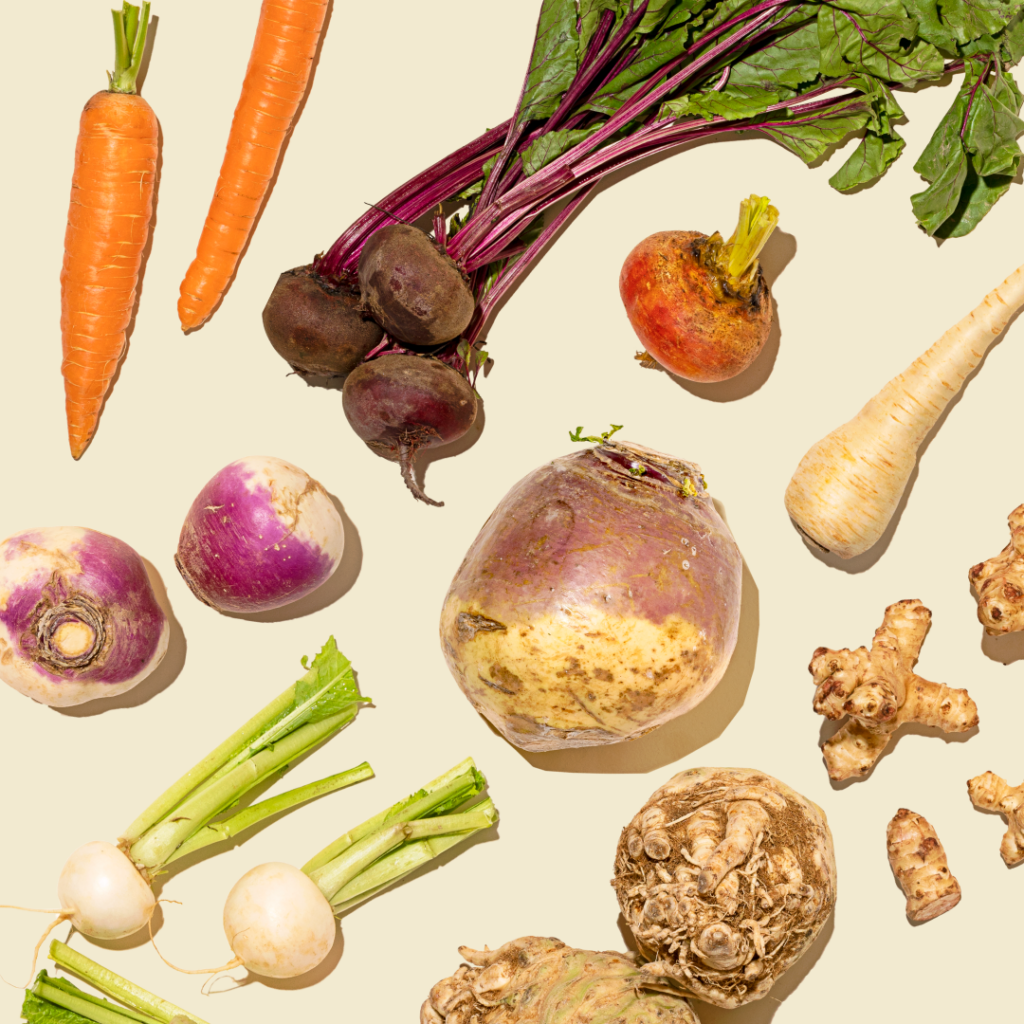
Yes, we know potatoes, onions, and radishes are roots. Consider this your catch-all guide for all the other root veggies that don’t fall into those other categories—your carrots, your turnips, and yup, your earthy-flavored, certain-to-stain-your-hands beets. Full of color and flavor, these roots are just as deserving of a place in your kitchen, and are excellent to lean on come fall and winter.
Beets
The Look: Beets are found year-round and are a great way to transition between seasons. They range in size, and come in a range of colors from red to gold to candy cane-striped.
The Taste and Texture: Beet flavor is basically synonymous with “earthy,” and red ones add color to green salads and roasted root veggie dishes, even if they sometimes stain your fingers. Bolden beets, on the other hand, are sweeter and pair well with sweet balsamic glazes.
The Best Use: Beets can be eaten raw, pickled, boiled, baked, juiced, steamed, and puréed. Their earthy flavor is easy to blend into sweeter baked goods, too. (And don’t toss those tops! They can be blended into quick pesto and even used as the base of salads.)
Try Them In: Chocolatey Beet Brownies and Chocolate Beetroot Pudding Pots
Keep reading: What’s The Difference Between Red and Gold Beets?
Carrots
The Look: Long and skinny, carrots are typically orange in color but can come in a variety of rainbow colors, from bright white to black, and pretty much every color in between.
The Taste and Texture: Crunchy and earthy when raw, yet sweet and soft when roasted.
The Best Use: What can’t the carrot be used in? Try them raw or roasted in salads, soups, sauces, purées, juices, mixed with other root veggies, pickled, and even in sweet desserts like carrot cake. You’ll also need carrots anytime you need mirepoix for stews, soups, and sauces. Plus, the leafy greens can be saved and blitzed into a pesto or fragrant carrot top chimichurri.
Try Them In: Zingy Carrot, Ginger, Turmeric Juice and Spiced Carrots with Harissa Yogurt
Celery Root (aka Celeriac)
The Look: This gnarled root has many more soft roots attached at its base—you’ll want to hack ’em off before cooking.
The Taste and Texture: A firm, crisp texture with a mild celery flavor that sweetens when cooked.
The Best Use: Because it’s similar to a potato in texture and relatively mild in flavor, it can be mashed, baked in a gratin, thinly sliced for a slaw, or even cut and baked into fries
Try It In: Crispy Celery Root and Leek Latkes or Celery Root, Cabbage, and Apple Slaw
Hakurei Turnips
The Look: Petite, white, and round.
The Taste and Texture: When roasted, this hardy root veggie goes from sharp and slightly spicy to mellow, creamy, and a little sweet.
The Best Use: Pair roasted turnips with honey and coconut oil, plus plenty of fresh herbs and a splash of lemon juice. Smaller white ones can also be mashed, puréed, roasted, and even pickled whole.
Try Them In: Honey-Roasted Turnips and Pickled Baby Turnips
Parsnips
The Look: Carrots and parsnips share the same notched, stick-like shape and snappy texture, giving this pair a high ranking on the swapability scale. Just bear in mind their differences in color—parsnips are a creamy, pale yellow while carrots can come in orange, purple, and bright yellow hues—and flavor when cooked.
The Taste and Texture: The slightly spiced, nutmeg-y notes in parsnips deepen in intensity when cooked.
The Best Use: Baked and mashed, roasted simply with fresh herbs, or swapped for carrots in cakes.
Try Them In: Spiced Parsnip Cake with Cream Cheese Icing and Parsnip and Sweet Potato Gratin
Purple-Top Turnips
The Look: Purple-top turnips live up to their name with white flesh and skin capped off with—you guessed it—a purple hue.
The Taste and Texture: On the milder side, but with a slight peppery bite
The Best Use: Like most root vegetables, turnips can be roasted, mashed, puréed, and blended into soups and sauces, or thinly sliced and eaten raw in salads and slaws.
Try Them In: Purple-Top Turnip and Apple Slaw and Turnip, Leek, and Potato Soup
Rutabaga
The Look: Not to be confused with the purple-top turnip, which looks similar, the rutabaga is much larger, heavier, and rounder.
The Taste and Texture: It resembles a potato in texture both raw and cooked, and turns subtly sweet when roasted.
The Best Use: Mashed, fried, or roasted, just as you would potatoes in a hash or fries.
Try It In: Easy Mashed Rutabaga and Roasted Rutabaga
Sunchokes (aka Jerusalem artichoke)
The Look: The sunchoke is a small, misshapen tuber that’s actually the edible root of the sunflower. Despite its knobby appearance, the sunchoke is relatively easy to cook with minimal prep and cook time.
The Taste and Texture: Like potatoes, turnips, and other root veggies, sunchokes have a distinct starchy taste. And, like a potato, when baked, the skin becomes crispy and the inside tender, sweet, and nutty.
The Best Use: Cooked or raw, sunchokes add subtle flavor to salads, soups, and more. Try Them In: Smashed Sunchokes with Thyme Butter and Sunchoke and Apple Salad
Keep reading: Four Delicious Dishes with One Bunch of Beets
Comments (2)
I would love to have thd roots my husband love the rutabaga and turnip bottom and love the carrots, beet, and other root or vegetable you may have yo sell
Happy to hear you’re a fan, Jacqueline! How do you guys like to enjoy rutabaga? Mashed is our favorite. We hope you and your husband can enjoy some root veggies in a Misfits Market box sometime soon! ????